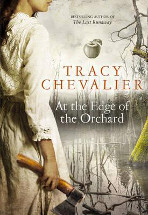At the edge of the orchard by Tracy Chevalier

HarperCollins, 2016. ISBN 9780008135294
(Age: 15+) Highly recommended. Pioneer life in the US. Farmers.
Apple growing. Family life. It is 1838. Deep in the Black Swamp of
Ohio, James and Sadie Goodenough try to scrabble out a living,
cutting down trees and attempting to grow the 50 apple trees that
they need to claim their holding. James loves the apples, especially
the sweet apple brought from his home in Connecticut, but Sadie is
addicted to the applejack they make. Robert one of their sons, loves
the apples too and watches out for his overworked sister, Martha.
When disaster strikes, Robert leaves the farm and roams across the
country, working on ranches and trying his hand at gold mining in
California. When he meets William Lobb, a naturalist who collects
seeds, he begins to work for him, but when his past catches up with
him, he has to decide whether he will continue on his solitary way
or make a home.
This a stunning book, meticulously researched, and the background of
apple growing and the appearance of the folk hero Johnny Appleseed
is fascinating. Pioneer life is described in all its brutality, the
loneliness, isolation, back breaking work, infant mortality and
alcohol addiction running counter with the family dramas as James
and Sadie battle it out about whether the apple trees should be
'eaters' or 'spitters' to make applejack. The hardships that the
family face are overwhelming and it is easy to imagine Sadie giving
into the enticement of applejack.
Chevalier uses the different voices of her characters to tell the
story. The reader learns about James' affection for the apples, his
jealousy of Johnny Appleseed and his trust in two of his children,
Robert and Martha. Sadie's narrative is less educated and more
strident, and it is easy to see the lonely, difficult woman in her
words. When Robert strikes out alone, it is his yearly letters to
his family that bring alive his character and his narratives are so
striking giving the reader information about the settlement of the
US, the gold rushes and the fever that overtook the miners, and the
hardship that women faced. The descriptions of the redwood and giant
sequoia groves, the efforts of William Lobb to collect saplings and
seeds to send back to England and the growing effect of tourism are
rivetting. Martha's letters are heart rending and really make a huge
impact about the reality of frontier life for young girls and women.
Notes are at the back of the book about the research Chevalier
carried out and add to the reader's knowledge of some of the real
life characters, Johnny Appleseed, William Lobb and others.
This book was a joy to read - the prose was vivid, the history
fascinating and the family dynamics engrossing.
Pat Pledger